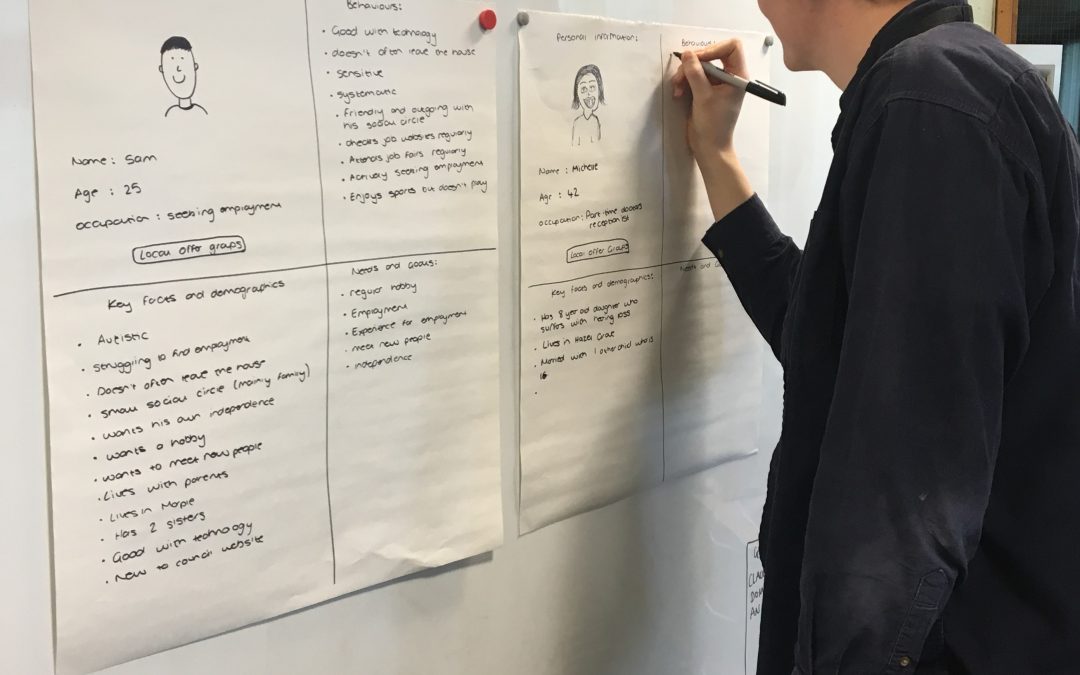As a UX Designer starting out in Digital by Design with the Content team I would like to share my experiences of UX (user experience designer) and Content and how they work together to produce great digital products.
Starting out in Content
When I came to Content over a year ago now, I knew little about writing web content, in fact I had never heard of User Experience (UX) and didn’t know what a Content Designer did. I managed to get a placement on the Digital by Design team as a Junior Content Designer. The first few weeks were tough but very exciting. I was taught things I never heard of before so it was very hard to understand certain terms and techniques. But all this helped me to see from a Content Designer’s point of view, using the GDS standards to write for the web.
Tone of voice
The hardest thing I had to adopt would be the tone of voice that the other Content Designers and previous Content Designers spent the time to build. The tone of voice is a way of showing personality to the user and adopting this was hard as I had to change the way I wrote. I have always been used to essay writing in college and sixth form and I always thought the more analytical and deep your writing can be, the better it would perform. But with web content, simplicity means so much more for the user.
Buying into Agile
I had to pick up agile rapidly and iteratively. Almost mirroring the way we actually work. I’d learn more and more as we build more and more. My managers would push me to go to stand-ups, ceremonies and meetings just to absorb as much as I could and develop the agile way of thinking. Overwhelming at first, I managed to pick it up soon after, I remember a switch clicking in my head and then just ‘getting it’.
Now I can’t really imagine Digital by Design without agile methodologies. It’s so integrated into the way we work now, its second nature.
Asking questions is ok
One important thing that the Content team taught me was that asking questions is ok. I came from a work history of independence, where you were told what to do then you go do it and see what the outcome is. It’s so much different in Digital by Design. Projects are built for co-design. Being a Content Designer taught me collaboration is the best direction for any project. We would use peer reviews as a technique to proofread work but to also make sure the direction of the project would be meeting user needs.
“Being a Content Designer taught me collaboration is the best direction for any project”.
When I started out I felt like asking questions was a sign of weakness. I felt like if I asked certain questions it was a sign that I didn’t know what I was doing. But this is the opposite, asking questions shows you’re getting involved, you are listening and you are intrigued by the subject. Asking questions ignite more talking which leads to more information and then more learning. This is probably one of the best pieces of advice you could give any new starter in any profession ‘asking questions is ok’, and the Content and UX team under Digital by Design always express this.

My first user testing session
UX and Content cross over all the time. Both teams utilise the benefits of conducting user testing sessions with the public. I was invited to help one of the UX designers conduct a guerrilla user testing session with some members of the public at Stockport Local Heritage Library. I was tasked with viewing the session with a Content eye and testing a prototype on a couple of users.
The session meant going up to random members of the public and asking if they would like to have 10 minutes to go over the prototype. I was nervous. The first person I asked rejected bluntly so this didn’t help my situation. Thankfully my next user kindly accepted. Whilst, going through the prototype with the user I got to see what UX was really about. I saw the struggles the users were facing first hand and how the UX designers were asking non-leading questions to get the users honest points of views. They were already coming up with solutions which the UX designers noted and then re-prototyped on to get the best possible User Experience.
This is where I saw the relationship Content and UX have. They both work in conjunction with each other, along with other teams like Developers, Business Analysts, Service Designers, and Product owners to produce great digital products. This is done through collaboration with services and teams within Digital by Design to build capabilities that users can use.
We are building great products that the end user can pick and trust if they want to. Ensuring our customers are confident that our website and digital products are easy to use is the first step towards our customers knowing that they can trust us with online transactions.
Having that one user testing session got me intrigued about the whole UX world.
Starting in UX
I started in UX only 4 months ago now and I felt more relaxed about it then I was with the Content role as I knew more about it and knew how to work Agile. However, I had a lot to learn. The UX world offers many techniques, theories, psychologies, tools and standards which I had to pick up. But the most important thing I had to pick up was empathy for the user. Understanding other people’s situations and seeing from their point of view was a very important factor I had to adopt. Content already did this very well and will do it for every project they start.
Adopting a User Centred Design approach for all services
User centred design is at the centre of everything we build in a project. As we expand our digital hub of information and online capabilities available through stockport.gov.uk, My Account and Healthy Stockport it is our job as UX designers to ensure that we are always to look to meet the needs of our users.
We are applying user centred design techniques in everything we are doing. Not just in UX but across the digital by design and wider council services.
We are also seeing changes with our own team. UX and Content work so closely together we have decided to sit under one overarching name; the ‘User Experience Team’.
We will be talking more about user centred design in further blogs to come.
“Good design is like a refrigerator—when it works, no one notices, but when it doesn’t, it sure stinks.” – Irene Au

